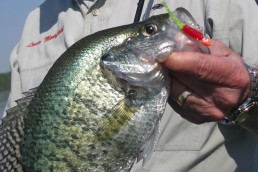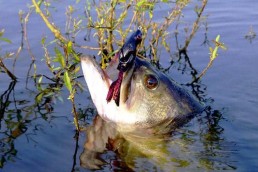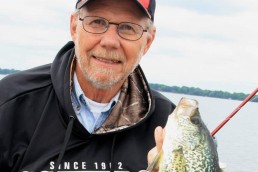Serious Summer Weed Crappie Patterns
SHARE THIS POST
Summer weed patterns vary from lake to lake with some waters that are practically devoid of weeds while others look like you could walk across the top. Some varieties grow from the bottom up so they are not always visible, especially out in deeper water.
The following are tips for catching crappies from the weeds in summer.
Lily pad jungles
“Reelfoot is a unique lake that will have areas covered up with lily pads,” says Louie Mansfield, Grizzly Jig Company owner.
“The pads are a good place to catch both bluegills and crappies at the same time.”
He also says that spring is the best season, but you can still find crappies there in the summer.
“I like to look for wood and pads together, like around stumps, duck blinds and near trees.”
Russ Bailey, host of Brush Pile Fishing TV, says pads are good from the Deep South to far northern states.
“I find a lot of fish positioned at the base of the pads,” Bailey said. “We have a misconception that a crappie will only feed up, but they will take a tube bounced off the bottom. The fish seem to stay close to the bottom until the water starts cooling in the fall when they’ll suspend up more.”
Bailey chooses ultra-light presentations and uses a 10 1/2-foot B‘n’M pole, 6-pound-test line, a 1/32-ounce jig head and a large Southern Pro tube.
“I like a big tube this time of year, but stick with a lightweight head. That lets me use a tiny ice float to detect the lightest of bites. The float keeps the right depth so the bait can be fished straight up and down or pitched out to get it farther from the boat.”
He says he likes to keep the bait on or near the bottom and pops the float to make the jig hop and then rest again.
Submerged weeds
Weeds are not always the most fun to get a hook into and out of. However, the right place with the right tactics can produce great results. Your electronics are key tools here. You may see no visual evidence of weeds as you go over a point in 10 feet of water, but your sonar shows the weeds, and fish, from the bottom up to 6 feet, critical in revealing the fish-catching location. Advanced electronics include side-image technology. These shoot signals out the side of the transducer to give a picture up to 120 feet away. This feature helps you cover a lot of water with one pass without going over the fish and spooking them.
Are you enjoying this post?
You can be among the first to get the latest info on where to go, what to use and how to use it!
Jeff Riddle often fishes Kentucky Lake, and understands the cover present.
“This lake has a lot of submerged weeds in the summer,” Riddle said. “There’s not a better place to catch crappies. Fish the edges of the weeds or fish a heavy weight and get into the weeds. Slow down and fish through them.”
Illinois guide and tournament fisherman Kyle Schoenherr says his method of weed fishing works anywhere.
“Every tactic begins with the right gear,” Schoenherr said. “I prefer a 12-foot B‘n’M jigging pole that allows me to pitch to the edges of the weeds. Pitching has a big advantage over casting because you have better control of the bait. Also, you have a better line angle for hooking up with the fish. I like a strong braid like Power Pro 15-pound-test line and an inexpensive, medium-large slip float.”
Schoenherr lip-hooks a minnow under a slip float. The larger float is good for a 1/4- or 3/8-ounce weight. A heavier weight is good for pitching to the weeds and maintaining control. The sinker is placed close to the minnow to keep it from roaming around and getting hung in the weeds.
Baits should be pitched to the weeds and allowed to remain for about a minute, he says. Aggressive fish will hit immediately but others may take their time.
“The good thing about the weeds is once you form a pattern it will be good day after day.”
Grass is good
“The water is hot and there is a thermocline,” says Steve Coleman, Classic Champ and Reelfoot fishing guide. “Oxygen is in the top layer so that’s where the fish will be. The thermocline will show up on your locator with all fish above the thermocline.”
He also says that he’ll look for a creek or river coming in where the oxygen and cooler water is coming in. He also believes lily pads, moss or grass can all be good cover.
“In summer one year, we caught huge fish in 2 feet of water in the grass.”
Final tips
Grass is structure, just like a ledge, bridge or brush pile; fish get in and hide to ambush prey. You’ve got to dial in to the right technique to get to them. Casting to weeds is fun, and fish will be feisty there and put up a good fight. Water will likely be clear near the weeds, but if you need to don’t forget to use your electronics. You can learn depths of the weeds and see how fish are holding. Once you find a pattern in the weeds it will likely last all day. And remember to stick with lightweight jigs and as light of line as you can use for the situation.
MWO
SHARE THIS POST
Did you enjoy this post?
You can be among the first to get the latest info on where to go, what to use and how to use it!
Tim Huffman
Tim Huffman specializes in crappie fishing, is editor for two crappie magazines, as well as writing for several others. In 2018, he published his sixth book, Limiting Out for Crappie, available at Amazon. His first article appeared in MidWest Outdoors in 1988.


